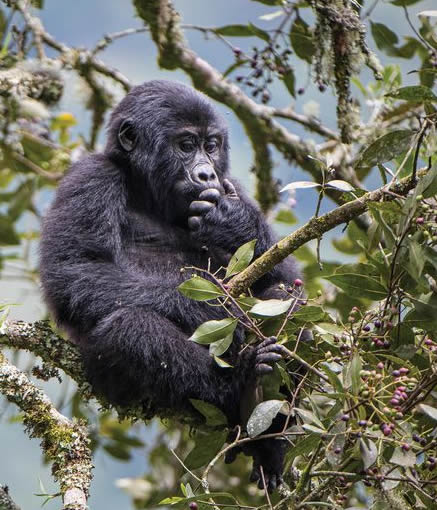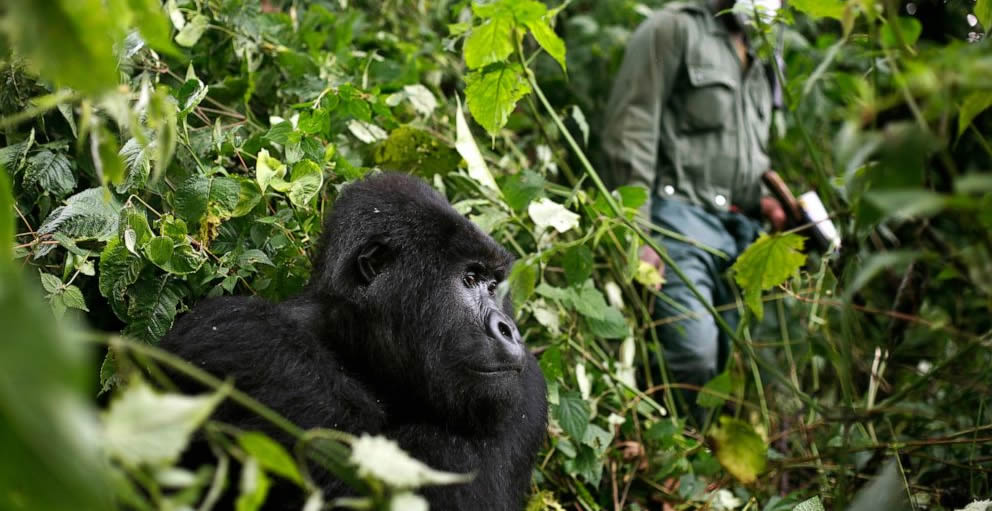Mountain gorilla tourism in Uganda takes visitors to trek habituated gorilla groups which previously must go through a period of habituation experience where they get used to seeing people into their natural habitat.  If mountain gorillas are not visited frequently can easily slide back to being wild and shall require to be habituated again when tourism resumes to prepare them to receive tourists without any problem.
If mountain gorillas are not visited frequently can easily slide back to being wild and shall require to be habituated again when tourism resumes to prepare them to receive tourists without any problem.
It’s been up to 3 months since the world closed off any kind of travel with the outbreak of the corona virus pandemic with no any inter-border crossing between countries.
Shortly after closing off, national parks and all wildlife reserves were closed off tourists so as to protect the wildlife in the parks as the Corona virus is real threat to wildlife too as well as human being especially the mountain gorillas who share up to 98% human DNA.
Gorillas are wild animals which have been trained to get used to human being but this is daily practice so that the gorillas don’t forget and go back to wild.
With total lock down for most of the countries worldwide, travel banns as well as mandatory quarantine has seen no visitors coming to trek mountain gorillas in Bwindi impenetrable forest and Mgahinga national park in Uganda.
As it turns-out the park rangers and guides are the only one safe to go trekking the gorillas daily for the gorillas to be used to seeing human being in the forest as well as to monitor each gorilla family movements, the health of the gorillas as well keep track of any new births in the families.
Researchers are another group that is allowed to see gorillas daily to keep track of the health of the gorillas and to treat any gorilla with illness
Health Precautions taken
Before heading off to the forest daily, all park guides, researchers must undergo health checkout before entering the forest so s to keep the gorillas safe. Gorillas re very prone to human infections especially the civid-19 threat and hence every person to access the forest must take available precautions.
Wash hands with soap and water before going into the forest to search for where the mountain gorillas are located. Also sanitizers are provided on ground as an option to make sure the local guides are safe to visit the gorillas.
The Uganda Wildlife Authority has provided face masks on ground for all the guides, wardens, security personnel to strictly put on so prevent any kind of diseases transmission to the gorillas who are very fragile to the covid-19 virus
All Bwindi national park staff on duty are only allowed to stay at park facilities for the of the corona virus and keep away from mingling with other people to curb any chance of transmission from person to person and to the gorillas eventually
The local community is not allowed to go gorilla trekking as the activity has been completely closed off everyone except for the staff who look out for the gorillas
The government in collaboration with the Uganda Wildlife Authority are funding the activities of conservation to protect and treat the mountain gorillas and their habitat and well as maintain the security of the gorillas in the forests.
Advantages of gorilla habituation
Mountain gorilla habituation trains apes to portray behavioral tolerance to seeing people into their habitat without being threatened.
Habituation is a gradual process which takes years of close observation by the habituation tech which comprises of researchers, local guides an wardens
At the start of the exercise, the gorillas show signs of stress and aggressiveness and with time start getting used to seeing humans daily and soon set used to having them without a problem.
Below are a number of advantages of habituating gorillas over leaving them wild
Easy medication and observation
It’s much easy to notice a sick habituated gorilla than a wild gorilla and medication will be administered to treat the gorilla. While wild gorillas are threatened by the presence of humans, it’s not easy to observe the behaviors of which gorilla is fine and which is sick and will only be noticed in the last stages when it’s very weak with small chance of saving it.
Gorilla Tourism
Gorilla habituation makes it possible for tourists to go gorilla trekking just seven meters close to the gorillas in their natural habitat which is such a beautiful adventure. This doesn’t only benefit the tourists but also the government as the gorilla permit which allows each tourist to go see gorillas costs $600 in Uganda, $1500 in Rwanda and $450 in democratic Republic of Congo. This income largely funds the country’s budgets, sponsors wildlife conservation and protection of the gorillas and their habitat as well as improve livelihood of loco communities
Studying gorillas more deeply
When gorillas are habituated it’s easy for researchers to study and understand them more deeply about their behaviors and the best way to protect them in the forest. It’s easy to get closer without a fight and easily interact with them
The best time to plan for gorilla trekking after covid-19
Without a cure or a vaccine yet in place to treat the corona virus, the advantage is that the world has managed to understand the virus and contain it from catching other people with an ability to open borders taking safety precautions to prevent catching the virus.
The best time to plan to travel for an African safari is best after a treatment is found for the covid-19 pandemic to rule out infected people mixing up with non-infected people and affecting the wildlife at the same time.
The best time to travel for gorilla trekking is the dry season when there is less rains, when the grounds are less slippery and its much easy to hike to find the gorillas.
The dry months cover December – March, June – October.
Rain is unpredictable in the tropical rain forests where the gorillas are found with a possibility of expecting rain even in the dry season which makes the adventure of gorilla trekking all round even the rainy period is a very good chance to see mountain gorillas in the wild.



